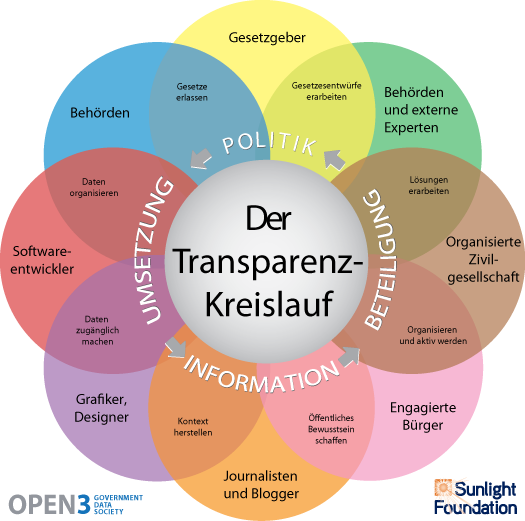
Im Artikel Introducing the Cycle of Transparency beschreibt Jake Brewer von der Sunlight Foundation die verschiedenen gesellschaftlichen Instanzen, ihre Rollen und ihr Zusammenspiel für einen transparenten Staat:
Government transparency is that rarest of political phenomena — a great idea with support across the political spectrum and popularity among the public. Yet, here we are in the 21st century with every tool we would need to make government more transparent and accountable, and still we are operating with a government that often behaves as it did in the 19th century.
So, transparent government is a good thing, but we do not yet have one. Now what?
This “Cycle of Transparency” demonstrates, in one image, the specific actions and the variety of actors that need to work together to create the open, transparent government we seek. We hope this graphic can be a useful tool in thinking about how to make city, state, federal, and even international governments more transparent.
Each type of actor and action complements the others in the Cycle to make every other element easier, or even possible at all. Of great importance is that just about anyone – from hardcore Internet developers to academics to government staff to reporters to activists – has a place in it.
Der im Artikel vorgestellte „Transparency Cycle“ war bis jetzt nur in englischer Sprache verfügbar. Tom Lee von der Sunlight Foundation hat mir dankenswerterweise das Sourcefile zur Verfügung gestellt, mit der ich eine deutsche Version erstellen konnte.
Vielen Dank in diesem Zusammenhang auch an Peter Parycek von der Donau Universität Krems für die Beratung bei der Umsetzung.
Die Grafik ist in folgenden Formaten zum Download verfügbar:
Der Transparenz-Kreislauf beruht auf einem Werk der Sunlight Foundation und wurde von Robert Harm überarbeitet und kann unter Berücksichtigung der Creative Commons Attribution 3.0 Austria Lizenz verwendet werden.



Hallo Robert,
Super Sache. Vielen Dank für deine Übersetzungs-Arbeit!
Interessant wäre grundsätzlich auch, wie und ob sich einzelnen Teilbereiche in der 3. Dimension überschneiden würden. Z.B. Gesetzgeber mit Journalisten etc…
LG
Harald Russegger
http://www.mondolingua.com/dcs
Kommentar von Harald Russegger am 21. Okt.. 2010 um 09:51 Uhr